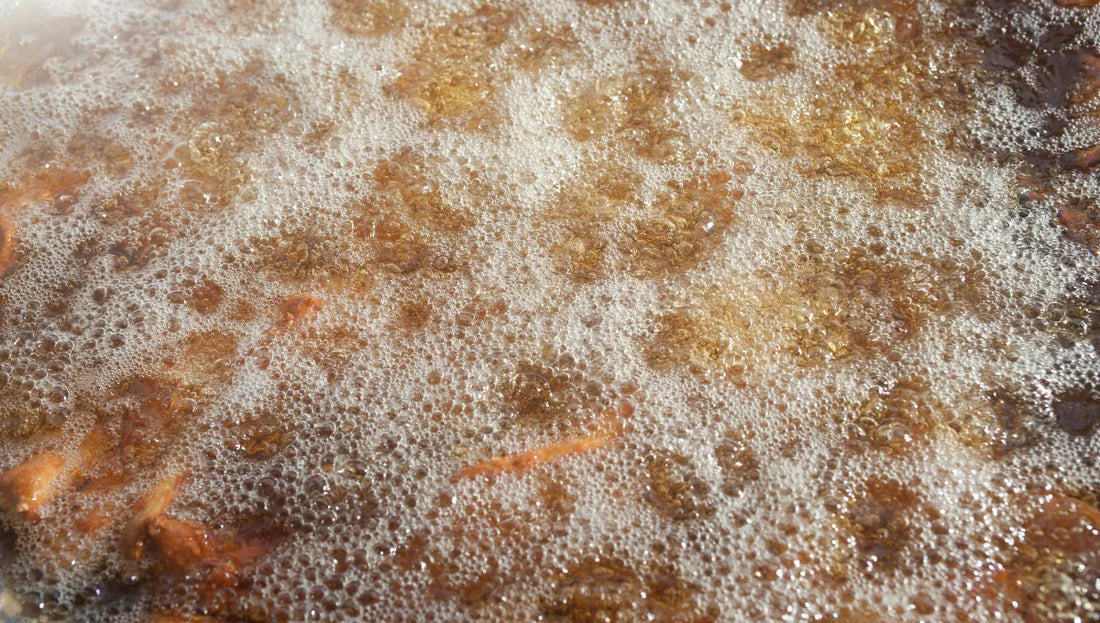
How to Keep Oil from Foaming: Chef Approved Methods
Share
Foaming oil can be irritating, whether you are trying to fry your favourite munchies or prepare your Diwali snacks.
Oil foaming can happen for many reasons, but you don’t have to worry, as sometimes it can be very easily solved.
Why is my Oil Foaming?

So, why does oil foam in the first place?
Various factors play a role in the foaming of oil. Let’s see all of them one by one.
1. Chemical Contamination
Sometimes, the oil can be contaminated with certain chemicals, resulting in foam at higher temperatures
2. Moisture Contamination
If you’re frying something wet, such as Aloo Vadas or Chaklis, it’s common for oil to start foaming as it absorbs the moisture from the food as you fry. This leads to steam bubbles trapped in the oil, resulting in foaming.
3. Degraded or Overused Oil
Oil starts losing its quality after every use. Overused oils oxidise over time, allowing air to be trapped more easily.
4. Overheating the Oil
Overheating the oil above its smoke point creates gas bubbles in the oil.
On the other hand, repeated high temperatures accelerate the degradation, worsening the oil quality much more quickly.
Is Foaming Oil Bad? Risks Explained
In short, yes, foaming oil is bad, and it has various risks. Let us see what they are one by one.
1. Reduced Cooking Efficiency
Foam causes poor heat transfer during cooking, thus resulting in poor cooking efficiency and uneven heat transfer.
2. Burnt Food
Uneven heat transfer causes your food to cook unevenly, resulting in undercooked or sometimes burnt food.
How to Prevent and Stop Oil Foaming?

If your oil is foaming, try the methods below to get rid of the foam.
1. Clear of Contamination
Make sure your oil stays clear of any contamination. Keep the moisture content low, and use oil filters from time to time to keep it clear and nice
2. Temperature Control
As we have seen, cooking or frying at temperatures higher than the oil’s smoking point can also cause it to smoke.
Make sure you use the oil at optimal and constant temperatures. If you need to fry at higher temperatures, try getting high smoke point oils or change your oil as soon as it starts foaming.
3. Agitation and Aeration Reduction
Avoid stirring the oil too much while cooking. This will stop the oil from absorbing any unnecessary moisture and air.
4. Reduce Food Moisture
Make sure you don’t put high-moisture food items directly into the oil. Dry them thoroughly (preferably with a paper towel) before frying or cooking.
5. Oil Replacement
Even if you follow all the preventive measures, you still have to replace your oil from time to time.
If you notice any discoloration or your oil starts foaming, it might be an indicator that it’s time to change your oil.
If you're already cooking and want to reduce the foam, you can add a small amount of fresh oil to the old oil, reducing the foaming.
Myths About Oil Foaming
There are many misconceptions about oil foaming.
Myths like all foaming oil is contaminated, foam means the oil is high-quality, or it works better are nothing but lies, and the reality is quite the opposite.
Conclusion
As we saw, foaming oil can be a culinary pain if not dealt with correctly.
To avoid this specific kind of headache, make sure you clean and change your oil regularly and always use oils from reputable brands.
Avoid overusing oil, as it’s not the best option for your health and can increase bad cholesterol.
Frequently Asked Questions?
Why does my oil foam a lot, even though I have not used it much?
The reason for the oil foaming a lot, even though you have not used it much, can be due to a low smoke point or impurities.
What to do when oil is foaming while frying?
If your oil starts foaming while frying, lower the flame, stop stirring, and consider adding a bit of fresh oil. It'll help manage the foam temporarily.
